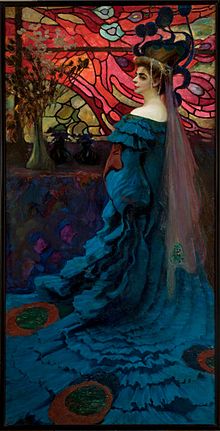Young Poland

| Part of a series on the |
| Culture of Poland |
|---|
 |
| Traditions |
|
Mythology |
| Cuisine |
| Festivals |
| Religion |
Young Poland (
Many of the exhibitions were held at the Palace of Art, also known as "Secession" (Secesja), the headquarters of the Kraków Society of Friends of Fine Arts, in Kraków Old Town.[2]
Philosophy
The term was coined in a
Literature

Polish literature of the period was based on two main concepts. The earlier was a typically modernist disillusionment with the bourgeoisie, its life style and its culture. Artists following this concept also believed in decadence, an end of all culture, conflict between humans and their civilization, and the concept of art as the highest value (art for art's sake). Authors who followed this concept included Kazimierz Przerwa-Tetmajer, Stanisław Przybyszewski, Wacław Rolicz-Lieder and Jan Kasprowicz.
A later concept was a continuation of romanticism, and as such is often called neo-romanticism.[4] The group of writers following this idea was less organised and the writers themselves covered a large variety of topics in their writings: from sense of mission of a Pole in Stefan Żeromski's prose, through social inequality described by Władysław Reymont and Gabriela Zapolska to criticism of Polish society and Polish history by Stanisław Wyspiański.
Writers of this period include also:
Music
In music, the term Young Poland is applied to an informal group of composers that include
Visual arts

In the period of Young Poland there were no overwhelming trends in Polish art. The painters and sculptors tried to continue the romantic traditions with new ways of expression popularised abroad. The most influential trend was art nouveau, although Polish artists started to seek also some form of a national style (including styl zakopiański or the Zakopane style). Both sculpture and painting were also heavily influenced by all forms of symbolism.[6]
Prominent Young Poland painters and sculptors include:[7]
- Ferdynand Ruszczyc
- Jacek Malczewski
- Jan Bukowski
- Jan Raszka
- Jan Stanisławski
- Jan Talaga
- Julian Fałat
- Józef Mehoffer
- Józef Pankiewicz
- Karol Frycz
- Kazimierz Sichulski
- Konstanty Brandel
- Konstanty Laszczka
- Leon Wyczółkowski
- Ludwik Konarzewski
- Maurycy Lilien
- Olga Boznańska
- Stanisław Wyspiański
- Teodor Axentowicz
- Teofil Terlecki
- Wacław Szymanowski
- Witold Wojtkiewicz
- Wojciech Gerson
- Wojciech Kossak
- Wojciech Weiss
- Władysław Ślewiński
- Włodzimierz Przerwa-Tetmajer
- Xawery Dunikowski
- Wacław Borowski
- Teodor Axentowicz
- Jan Bukowski
See also
Notes and references
- ^ "Young Poland movement". Encyclopedia Britannica. Retrieved 25 April 2020.
- ^ "Secesja w Krakowie – cz.1" (in Polish). Archived from the original on 2020-09-23. Retrieved 2020-09-06.
- ISBN 9780719037276. Retrieved 25 April 2020.
- ^ "Polska, literatura, Młoda Polska". Virtual Shtetl | POLIN Museum of the History of Polish Jews. Archived from the original on 25 October 2021. Retrieved 25 April 2020.
- ^ a b "MŁODA POLSKA". Archived from the original on 24 May 2021. Retrieved 25 April 2020.
- ISBN 978-0-7546-0693-2.
- ^ "6 Must-Know Painters of the Young Poland Movement". Culture.pl. Retrieved 23 April 2020.
- Dobrowolski Tadeusz, Sztuka Młodej Polski, Warszawa 1963.
- Słownik artystów polskich i obcych w Polsce działających. Malarze, rzeźbiarze, graficy, t. II, Wrocław 1975 (Urszula Leszczyńska).
- Puciata-Pawłowska Joanna, Konstanty Laszczka, Siedlce 1980.
External links
- Griffin, Julia (2021). "Matejko, Father of 'Young Poland', a talk by Julia Griffin". National Gallery London. Archived from the originalon 7 May 2021. Retrieved 7 May 2021.
- Stanisław Wyspiański, biography from the Adam Mickiewicz Institute
- First review of Wesele (The Wedding Reception)
- Wyspiański’s Herbal
- Wyspiański’s paintings
- Wyspiański stained-glasses
- Kultura polska - Konstanty Laszczka
- Dobrowolski Tadeusz, Sztuka Młodej Polski, Warszawa 1963.
- Słownik artystów polskich i obcych w Polsce działających. Malarze, rzeźbiarze, graficy, t. II, Wrocław 1975 (Urszula Leszczyńska).
- Puciata-Pawłowska Joanna, Konstanty Laszczka, Siedlce 1980.
